Nag Panchami
Nag Panchami
Nag Panchami is a Hindu festival dedicated to the worship of serpents, especially Nag Devta, symbolizing fertility, protection, and prosperity. Devotees offer milk, flowers, and prayers at snake idols or anthills, seeking blessings for family well-being and protection from snakebites. It is celebrated on the fifth day of Shravan month.
Nag Panchami is a Hindu festival that honors serpent deities, seeking protection, prosperity, and harmony with nature.
Nag Panchami
Nag Panchami is a Hindu festival dedicated to serpent worship, especially Nag Devta. Celebrated on the fifth day of Shravan month, devotees offer milk, flowers, and prayers at snake idols or anthills, seeking protection, prosperity, and family well-being. The festival symbolizes respect for nature and harmony with all living beings.
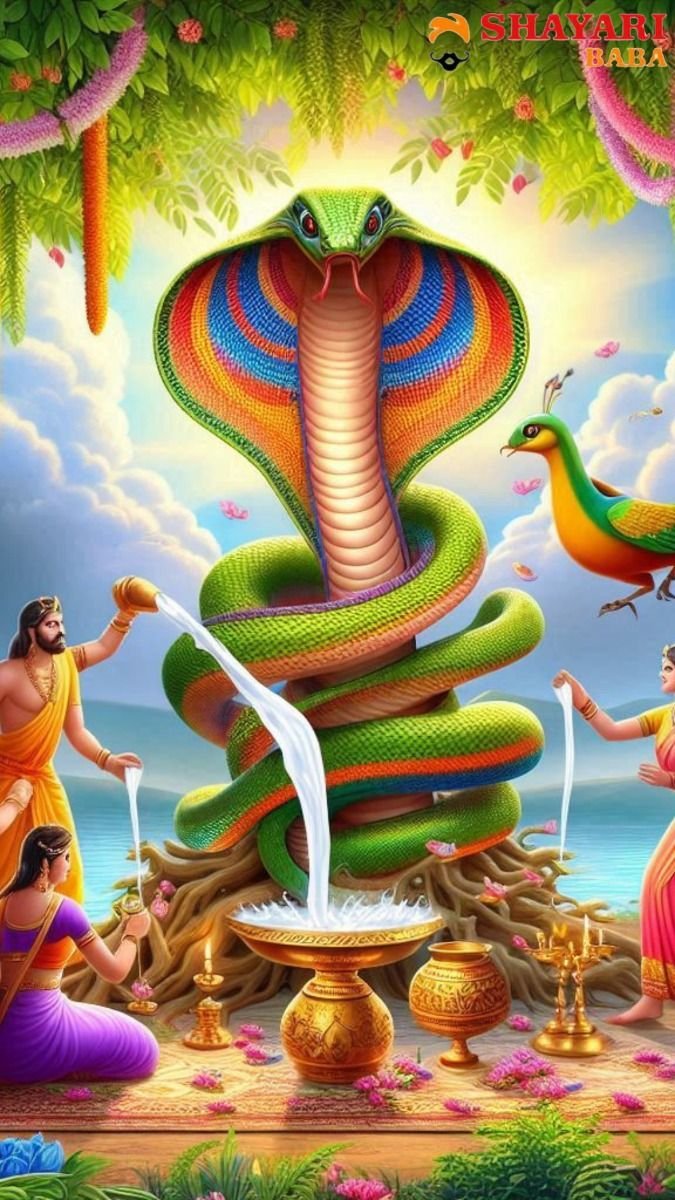
Mythological Significance & History
Nag Panchami is an important Hindu festival dedicated to the worship of serpents, especially Nag Devta, who are regarded as powerful and divine beings in Indian culture. It is celebrated on the fifth day (Panchami) of the holy month of Shravan, a period considered highly auspicious for devotion. According to Hindu belief, snakes symbolize fertility, prosperity, and protection, and offering prayers to them brings blessings for family well-being, safety, and harmony.
On this day, devotees visit temples and offer milk, flowers, turmeric, and sweets to snake idols or images, while in some regions, milk is poured into snake holes and anthills. Fasting, chanting mantras, and reciting stories related to Lord Shiva, Lord Vishnu, and serpent deities are common practices. Nag Panchami is also linked with mythology, as snakes are associated with Sheshnag, Vasuki, and even Lord Shiva, who wears a serpent around his neck.
The festival holds agricultural significance too, as snakes protect crops by controlling pests and rodents. Thus, Nag Panchami reflects gratitude toward nature and its creatures. In villages, traditional songs and rituals are performed, while in urban areas, devotees conduct pujas at home.
Nag Panchami is not only a religious observance but also a reminder of the need to respect and live in harmony with all living beings.
(220 words)

Significance of this Nag Panchami
Nag Panchami is a traditional Hindu festival that honors serpents, worshipped as divine beings and protectors in Indian culture. Celebrated on the fifth day of the Shravan month, it holds deep spiritual and cultural significance. Snakes are considered symbols of fertility, prosperity, and protection, and prayers to them are believed to ensure family safety, harmony, and good fortune.
On this day, devotees offer milk, flowers, turmeric, and sweets to snake idols, pictures, or live snakes, especially at anthills or near temples. Many observe fasts, chant mantras, and recite stories associated with serpent deities like Sheshnag, Vasuki, and Takshaka. Snakes are also closely linked to Hindu gods: Lord Vishnu rests on the serpent Sheshnag, and Lord Shiva wears Vasuki around his neck, making serpent worship highly sacred.
Nag Panchami is also celebrated with regional variations. In Maharashtra and Karnataka, women draw snake images at doorsteps and perform rituals for family well-being. In North India, fairs and processions featuring snake charmers are held. In rural areas, farmers pray to serpents for protection of crops and good harvests, acknowledging their role in balancing nature by controlling pests and rodents.
Beyond rituals, the festival conveys a deeper message of coexistence and respect for all creatures. By worshipping snakes, devotees express gratitude toward nature and seek divine blessings for a prosperous and safe life.
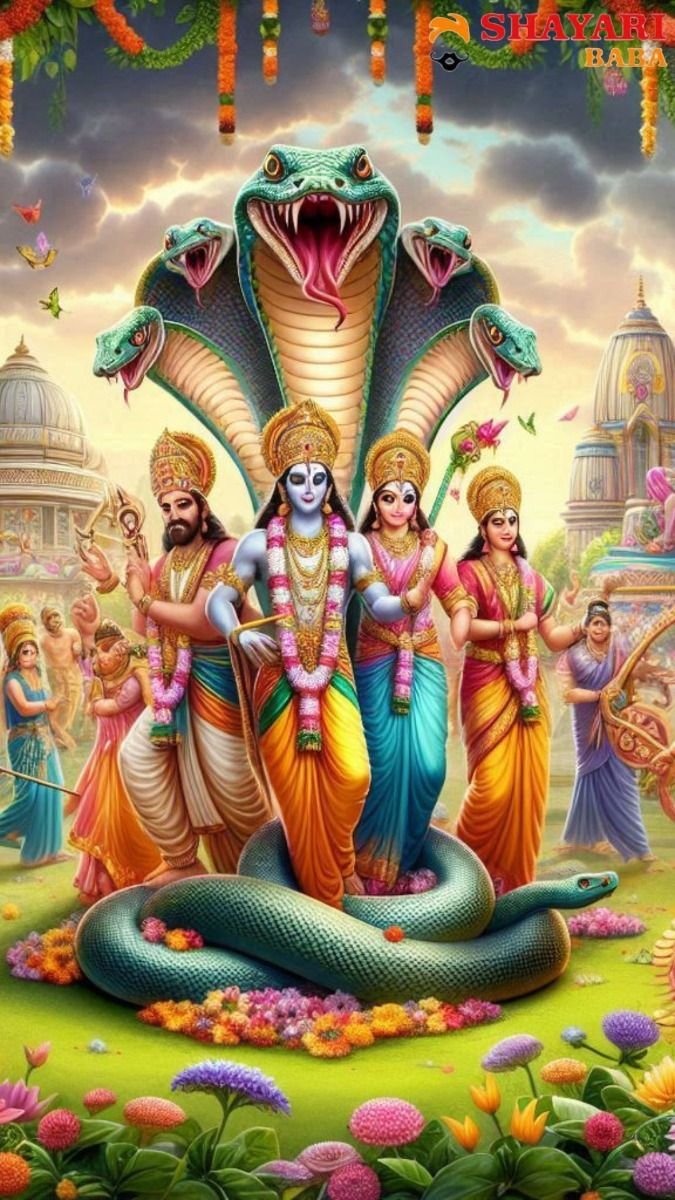
Rituals & Traditions of Nag Panchami
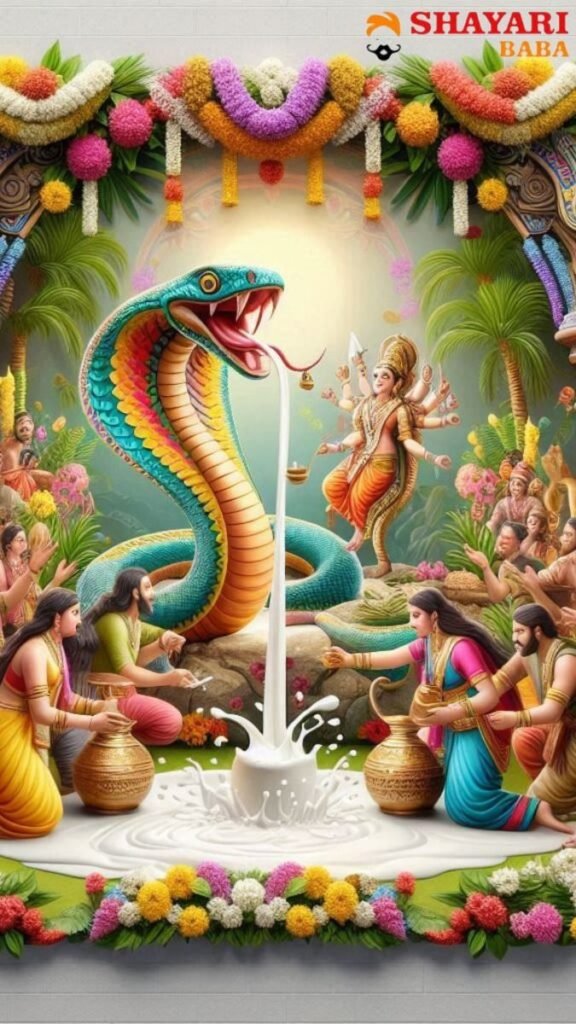
Nag Panchami is a revered Hindu festival dedicated to the worship of serpents, celebrated on the fifth day (Panchami) of the Shravan month, which usually falls in July or August. Serpents, or Nagas, hold a special place in Hindu mythology and are regarded as divine beings connected with fertility, prosperity, rain, and protection. Offering prayers to Nag Devta on this day is believed to safeguard families from misfortune, ensure good health, and bring peace and prosperity.
On Nag Panchami, devotees worship serpent deities in temples, at anthills, or through idols and images. Milk, flowers, turmeric, rice, and sweets are offered, and many people observe fasting as a mark of devotion. In villages, milk is poured into snake holes as an offering, while in urban regions, pictures or clay images of snakes are worshipped at home. Mantras dedicated to serpent gods are chanted, and legends from the Puranas such as those of Sheshnag, Vasuki, and Takshaka are recited. Snakes are also associated with major deities—Lord Vishnu rests on Sheshnag, and Lord Shiva wears a serpent around his neck—making their worship sacred and auspicious.
The festival is celebrated differently across India. In Maharashtra and Karnataka, women draw images of snakes on walls or doorsteps and perform rituals for family well-being. In Uttar Pradesh and Bihar, large fairs and processions with snake charmers displaying live cobras are common. Farmers also perform rituals to protect their crops, as snakes play an ecological role by controlling rodents and pests.
Beyond the rituals, Nag Panchami carries a symbolic message of harmony with nature and respect for all living beings. It reminds people of the balance between humans and the environment, highlighting the importance of coexistence. Thus, Nag Panchami is not only a religious observance but also a cultural and ecological celebration that emphasizes reverence, gratitude, and the eternal victory of dharma and balance in nature.
Spiritual Importance & Cultural Significance
Nag Panchami is a sacred Hindu festival dedicated to the worship of serpents, observed on the fifth day (Panchami) of the holy month of Shravan, usually in July or August. Snakes, or Nagas, are deeply revered in Hindu mythology, symbolizing fertility, prosperity, rain, and protection. Worshipping Nag Devta on this day is believed to protect families from snakebites, bring peace and harmony, and ensure prosperity.
Devotees observe Nag Panchami with great devotion by offering milk, flowers, turmeric, and rice to snake idols, pictures, or live serpents. In villages, people pour milk into anthills or snake holes as offerings, while in urban areas, clay or metal images of Nagas are worshipped at homes and temples. Fasting, chanting mantras, and reciting stories of serpent deities like Sheshnag, Vasuki, and Takshaka are common practices. Snakes are also closely linked with Hindu gods—Lord Vishnu rests on Sheshnag, and Lord Shiva adorns a serpent around his neck—making serpent worship highly sacred.
Nag Panchami is celebrated with regional variations. In Maharashtra and Karnataka, women draw images of snakes at doorsteps or on walls and perform rituals for family safety and prosperity. In North India, especially in Uttar Pradesh and Bihar, fairs and processions are organized, and snake charmers display cobras to whom devotees offer milk. Farmers also pray to serpents for a good harvest, acknowledging their role in protecting fields from rodents and pests.
The festival also carries mythological significance. One famous legend describes Lord Krishna subduing the poisonous serpent Kaliya Naag in the Yamuna River, symbolizing the victory of good over evil. Such stories inspire devotees to place their faith in divine protection.
Beyond its rituals and stories, Nag Panchami conveys a deeper message of respect for nature and all living beings. It emphasizes coexistence, ecological balance, and gratitude toward creatures that play an important role in human life. Thus, Nag Panchami is both a religious and cultural celebration, reminding devotees of harmony between mankind, nature, and the divine.
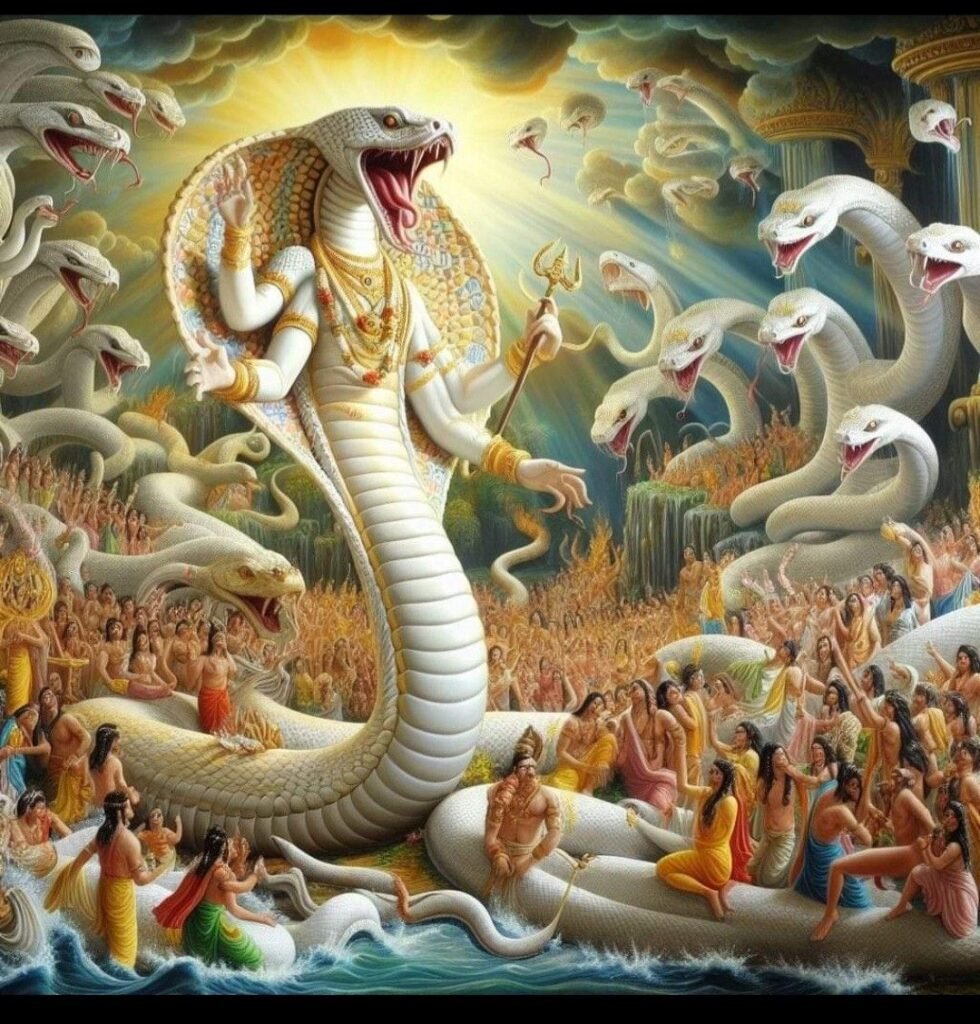
Food & Sweets & Modern Celebrations
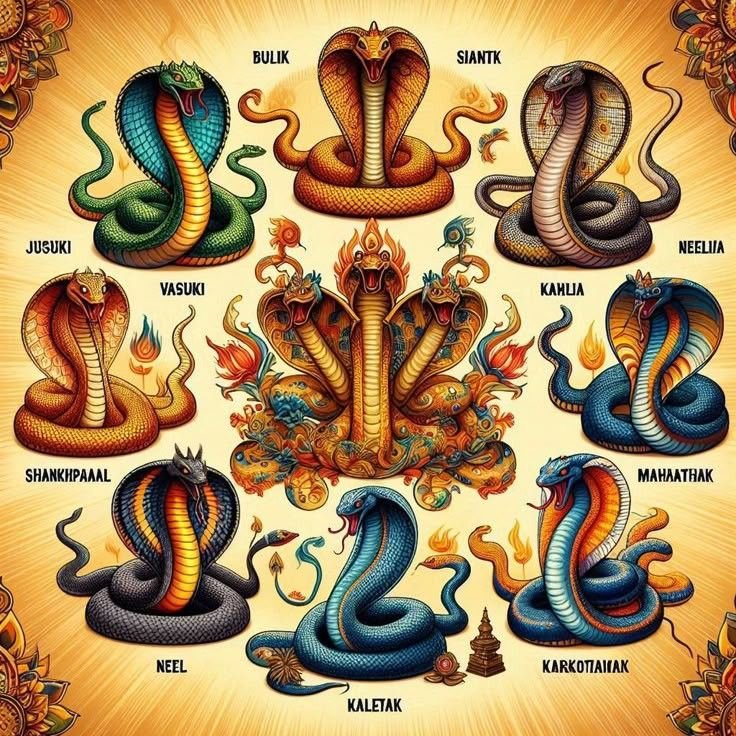
Nag Panchami is an important Hindu festival dedicated to the worship of serpents, observed on the fifth day (Panchami) of the holy month of Shravan, which usually falls in July or August. Serpents, or Nagas, hold a special place in Hindu mythology and are regarded as divine beings associated with fertility, prosperity, rain, and protection. Worshipping Nag Devta on this day is believed to safeguard families from snakebites, remove obstacles, and bring blessings of health, wealth, and harmony. The festival also reflects gratitude toward nature and respect for creatures that maintain ecological balance.
On this day, devotees offer milk, flowers, turmeric, rice, and sweets to snake idols, pictures, or live serpents. In rural areas, people pour milk into anthills and snake burrows, while in cities, clay or metal images of serpents are worshipped in homes and temples. Many observe fasting, chant mantras, and recite stories from the Puranas that describe the glory of serpent deities such as Sheshnag, Vasuki, and Takshaka. The association of serpents with Hindu gods further increases the festival’s importance—Lord Vishnu rests on Sheshnag, while Lord Shiva adorns Vasuki around his neck.
Nag Panchami is celebrated differently across regions of India. In Maharashtra and Karnataka, women draw snake images on walls or doorsteps and perform rituals for the well-being of the family. In North Indian states like Uttar Pradesh and Bihar, large fairs and processions are organized, where snake charmers carry cobras in baskets, and devotees offer them milk and prayers. Farmers, in particular, worship serpents to protect their crops, as snakes help control rodents and pests in fields, ensuring a healthy harvest.
The festival is also enriched with mythological stories. One of the most popular legends narrates how Lord Krishna defeated the venomous Kaliya Naag in the Yamuna River, protecting the villagers of Gokul and restoring the purity of the river. This tale symbolizes the triumph of good over evil and the divine protection offered to devotees. Another belief connects Nag Panchami with the Mahabharata, where the great serpent Takshaka plays a significant role.
Beyond religious practices, Nag Panchami conveys a universal message of coexistence and ecological awareness. By honoring serpents, devotees express reverence for nature and acknowledge the balance between humans and other living beings. Thus, Nag Panchami is not only a religious observance but also a cultural reminder of gratitude, harmony, and the eternal bond between mankind, nature, and the divine.




















































